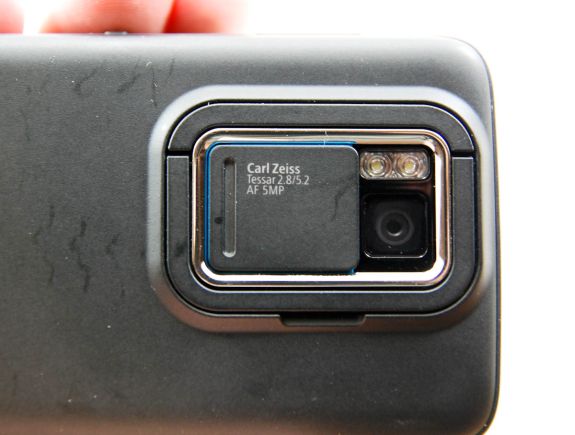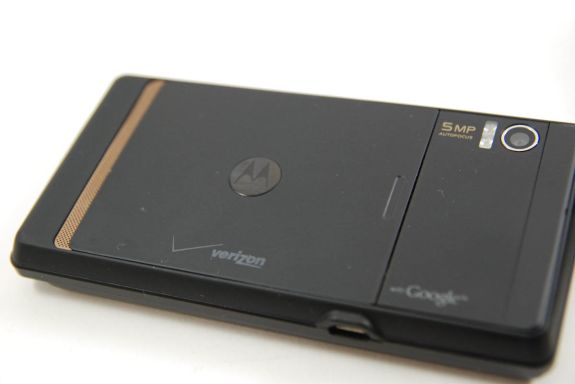Two OMAP 3430 Phones: Nokia N900 and Motorola Droid
by Brian Klug on June 10, 2010 9:29 PM EST- Posted in
- Smartphones
- N900
- Maemo
- Motorola Droid
- Droid
- MeeGo
- Android
- Mobile
N900 Camera
I've already talked briefly about the N900's camera, which is true to form for Nokia devices and pretty impressive. The software implementation that Nokia has put together for the N900 on Maemo is well polished. As mentioned before, sliding the camera cover open while the device is on immediately launches the camera application, or you can get there from the applications window. After launching, there are black bars at each side, the right side of which is used for settings icons. Nokia has included a ton of options here, including optional geotagging, settings for exposure, ISO, and preset shooting modes. You can capture in 3.5 megapixel or 5 megapixel modes, and have ISO 100, 200, 400 or automatic to choose from. In auto mode, it seems like the camera can go all the way to ISO 800 if necessary, but you can't set that manually. True to the rest of Maemo, the camera only works in landscape orientation.
What's really impressive is just how sharp and fluid the N900 camera preview looks while you're shooting. Suffice it to say, only the HTC Incredible really rivals how sharp and detailed the images look in the live preview. Framerate is always solid, and I just left the settings on defaults because I was pleased with the quality. The hardware button itself is two-position. Pushing halfway down triggers autofocus, pressing all the way takes the shot. One of the nice things is that if you jam the shutter button all the way down, it really takes the picture immediately; there's no mandatory AF run before actually capturing. This is potentially really handy if you're trying to capture something quick action and you're already confident it's in focus.
The N900 can capture videos at up to 848x480 at 25 fps in MPEG-4 format with AAC audio. That's an aspect ratio of 16:9 interestingly enough. I was a bit concerned initially about video being shot at 25 fps, but this is becoming more and more the case with 720P class smartphone video. Quality itself is very good as we'll see in a second.
Motorola Droid Camera
The Motorola Droid packs a slightly more standard 5 megapixel camera, also with autofocus and dual LED flash. While it doesn't carry fancy Carl Zeiss branding or advertise what kind of optical lens system drives it, it's likely the same or a very similar OmniVision camera sensor at the core. The Motorola Droid also supports video recording, though at slightly lower 720x480 resolution at slightly higher 30 fps. Video is encoded in H.264 and audio is AAC.
The camera application for the Motorola Droid is also stock Android 2.x. Love it or hate it, the application is essentially uniform across the platform with the exception of HTC's custom camera application like on the HTC Incredible. You've got settings for most of the basic things, but just not as much as you do on the N900 - though both of these have many more settings than iPhone OS which always handles everything with no chance for user override.
The camera can be launched either from the applications menu, or by pressing the dedicated camera button all the way down while the device is on. Motorola talked a fair amount about the copper colored camera button which - I guess - is a feature. Unfortunately, I did encounter a considerable amount of bugginess with the Droid's camera. Launch would periodically take a very long time (well over 8 seconds), in which case you'll probably just give up and move along, and I noticed a very strange quirk where switching from landscape to portrait (eg shutting the keyboard drawer) would result in camera UI elements being drawn in the wrong place. A few times, the frame around the camera preview would just render inside atop the image, which is very frustrating. Killing and relaunching fixes that, though.












68 Comments
View All Comments
DaveGirard - Saturday, June 12, 2010 - link
sweet Jesus, that Nokia phone is huge. Does it double as an ice cream sandwich cover?metafor - Sunday, June 13, 2010 - link
Cortex is the CPU designed by ARM. This is available as a hard-macro (layout already done) or soft-macro (just the functional RTL). Some companies license this in either version. For those who license the soft-version, such as TI, nVidia and Broadcom, they can do a customized place-and-route along with clock-tree optimizations and voltage partitioning to try to make the design run faster.However, the micro-architecture is the same.
A few companies have ARM architectural licenses (Apple, Qualcomm, Marvell) and instead of licensing the Cortex line of processors, they design their own. The micro-architecture is developed independent of what ARM did in their Cortex series albeit there will often be similarities.
Scorpion inside Snapdragon was developed in the course of years and while it has many similarities to the A8 from a power-point standpoint, the micro-architecture underneath was designed from the ground up. Everything from the branch predictors, the cache controller, exception handling, execution units and most notably, a partially OoOE scheduler and retirement buffer.
There's also the 128-bit, fully pipelined, partially OoOE SIMD/FP unit.
medi01 - Sunday, June 13, 2010 - link
Well, I find it very strange, that "incidentally" iPhone is never shown in bad light. Could you please update your side to side comparison?Impulses - Wednesday, June 16, 2010 - link
Personally I think there's better things for you guys to do or test with your time... Who cares if a phone's screen colors are more or less accurate, as long as they aren't outright flawed or ugly to look at it shouldn't be a big deal, not like anyone's gonna be doing any pro content editing work on their phones! (I don't even own an AMOLED screen so I'm not particularly biased one way or the other, I own an EVO atm)mojtabaalemi - Saturday, June 19, 2010 - link
I hate the design of nokia mobile phones . in my idea an iphone is far far better !paihuaizhe - Sunday, June 20, 2010 - link
(nike-alliance).(com)=>is a leading worldwide wholesaler company (or u can sayorganization)
arnavvdesai - Saturday, June 26, 2010 - link
I was just wondering if the author had installed AdBlock+ and then run the browser speed numbers or without it being on. If it was not installed which is what I am guessing from the photos, did you notice an improvement in the render times when it was installed. I actually bought the phone recently after seeing it on sale for 380$ and wanted to know the details. Also, I have heard that the current build of the OS allows potrait mode even for the browser(although it has to be activate through some setting) and not just the phone.drwiremore - Sunday, July 4, 2010 - link
Amanda, delighted to have found you. Given the issues in the title, affecting 20~50% of MOTO Droid users, was surprised to see no mention of it. The MOTO boards are alive with disdain and some feel an in you face attitude by Motorola Droid 2 and X announcements. Would you do an iPhone like analysis of voice, antenna and signal issues across Verizons Droids: HTC incredible and MOTO Droid. Your scientific analysis would be welcomed.